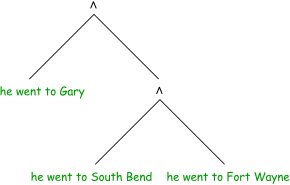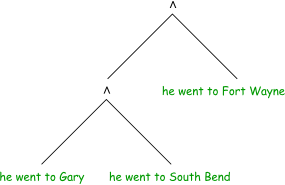
A

B
Fig. 2.1.5-1. Two analyses of a serial conjunction.
Although conjunction can compound sentences only two at a time, the word and in English can be used with any series of more than two items. To analyze a serial conjunction like He went to Gary, South Bend, and Fort Wayne, we need to regard the sentence as the result of two uses of conjunction, first to join two of the components and then to tack on a third. There are two ways of doing this and, although they both have the same truth conditions, they arrive at their common meaning in different ways.
We can represent this difference in our symbolic notation by using parentheses:
There are a number of ways of describing the difference displayed here. We can say, first, that in each case a different one of the two uses of conjunction is the main connective or the one at the top level. The main or top-level connective is the operation that would be used last in forming the sentence, and it marks the place the sentence would be broken first when it is decomposed. In the first sentence above, it is the first use of conjunction that is the main connective or the one at top level while, in the second sentence, it is the second use.
Another way of describing the difference between the two analyses is to speak of the scope of a connective, the part of the whole sentence that is made up of the connective and the components it applies to. Thus the scope of the first ∧ in the first of the sentences above is the whole sentence while the scope of the second ∧ is the portion in parentheses. This situation is reversed in the second sentence; there, the scope of the first ∧ is limited by the parentheses and is included in the scope of the second ∧.
| He went to Gary ∧ ( | he went to South Bend ∧ he went to Fort Wayne | ) |
| ( | He went to Gary ∧ he went to South Bend | ) ∧ he went to Fort Wayne |
So we say that the two examples differ in the relative scope of the two uses of conjunction. In one, the first use has wider scope; in the other, the second has wider scope.
These two ideas are depicted together in Figure 2.1.5-1. The main connective of each analysis appears quite literally at the top level, and the scope of each connective is the portion of the analysis that branches out from under it.
The parentheses of our symbolic notation for these analyses can be seen as a way of representing this sort of structure without resorting to two dimensions.
Although such scope distinctions make no difference in the truth conditions of English sentences, they are possible syntactically—as in
Here, also is used to emphasize the break made by one and. Use of punctuation is another way to emphasize one of the two ands and raise it to the top level—as in
In the absence of devices like the use of also, syntactic grouping, or punctuation, the normal order of reading probably would lead us to interpret the second and as the last one used in forming the sentence—that is, as the main operation.
Still another common way of making such distinctions is to exploit the power of and to conjoin words or phrases as well as complete clauses. For example, compare (in which the objects of prepositional phrases are underlined)
In each case, one and conjoins prepositional phrases and the other conjoins nouns as the object of one of these phrases.
A final way of representing scope distinctions in English is one we have adapted to represent conjunction using the expression both … and …. All things being equal, we will interpret the second of two ands as having the wider scope, but this presumption can be defeated by adding the word both to get, for example
This sentence has the form φ ∧ (ψ ∧ χ); and, in general, the word both has roughly the same effect as a left parenthesis in our symbolic notation. Indeed, when we represent the forms we have been considering using English notation we get this:
both he went to Gary and both he went to South Bend and he went to Fort Wayne
both both he went to Gary and he went to South Bend and he went to Fort Wayne.
The word both appears here just where a left parenthesis would in a symbolic analysis if we were to add parentheses surrounding the whole sentence.
Of course, our English notation uses both in many cases where both would not appear in ordinary English and even where a left parenthesis would not ordinarily appear in our symbolic notation. This is because the English notation is designed to make the scope of connectives unambiguous in cases where ordinary English is ambiguous. And without anything to serve as a corresponding right parenthesis, the word both may be needed in some places where a left parenthesis is not.
For example, suppose we attempt to express the form (φ ∧ ψ) ∧ χ, using and in place of ∧ and both in place of the left parenthesis. We would get
both φ and ψ and χ.
If we take both to mark the left end of the scope of the first conjunction (as the left parenthesis does in the symbolic expression), we are still left with no indication of the right end of its scope: is the second component only ψ or the whole of ψ and χ? If we supply a both for every and, we can write (φ ∧ ψ) ∧ χ as
both both φ and ψ and χ.
This is hardly elegant prose, but it does make the grouping definite; finding a second both immediately following the first, we know the first component of the main conjunction is itself a conjunction. It is also possible, and sometimes useful, to mix symbolic and English notation, using the word and with grouping marked by parentheses.
Although scope distinctions can be made in English in these ways, the English and is often applied to a series of items that are all on the same level. It would be possible to treat conjunction as an operation that was similar to the English and in this respect, but it would cost us the trouble of more complex accounts of the properties of conjunction without yielding much greater insight. We can (and often will) mimic the way addition and multiplication are usually treated in algebra and drop parentheses when they make no difference in the value of an expression. This introduces no real complications but it has limitations. Since our principles concerning conjunction will be stated only for 2-component conjunctions, we can apply them to a run-on conjunction like φ ∧ ψ ∧ χ—or, in English notation, φ and ψ and χ—only after we have chosen one of the two conjunction symbols as marking the main operation. And, although we could regard either the first or last of the three components as a component of the top-level conjunction, the middle one ψ always ends up as a component of the lower level conjunction, so we really have not put the three components on the same level.